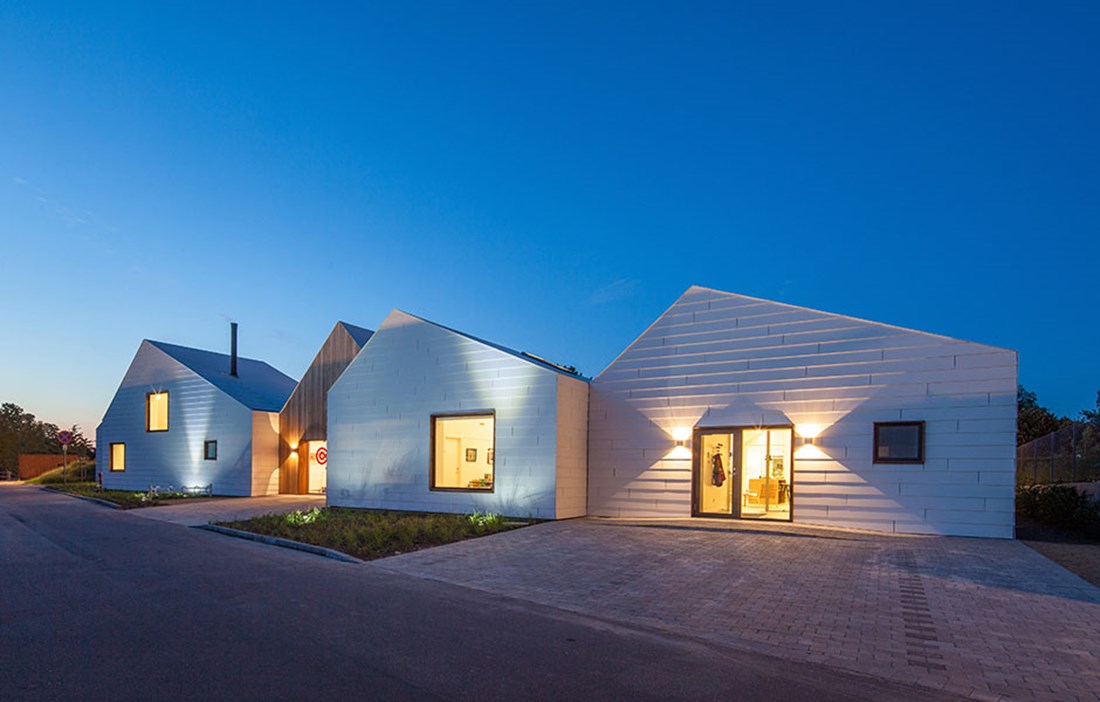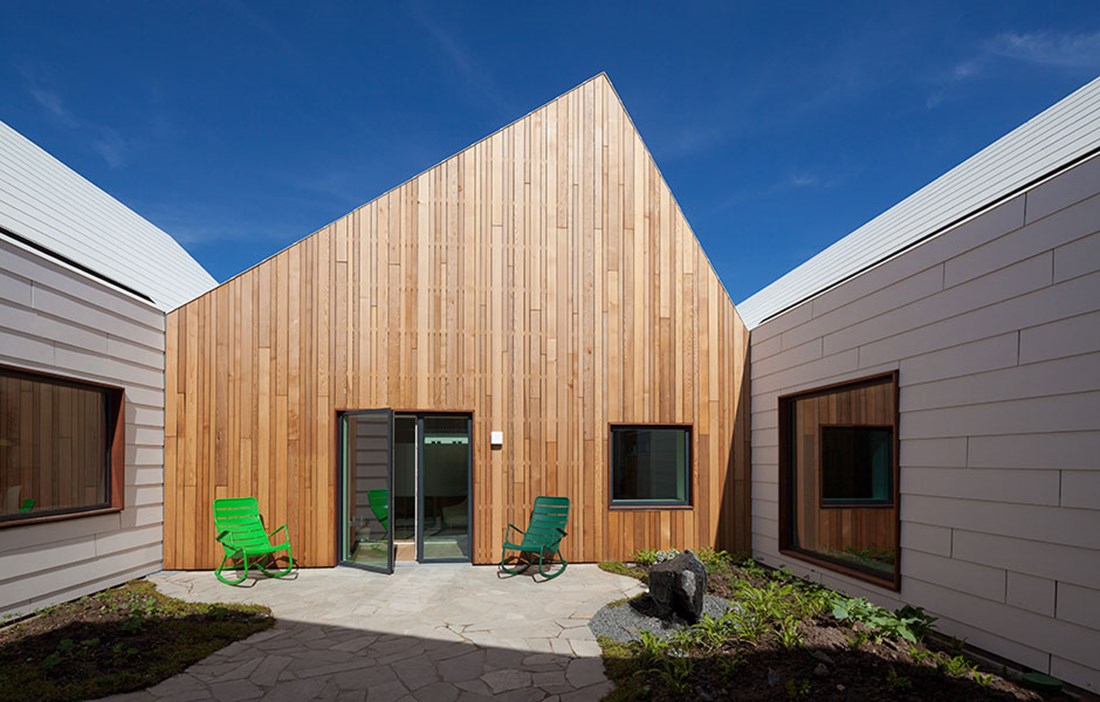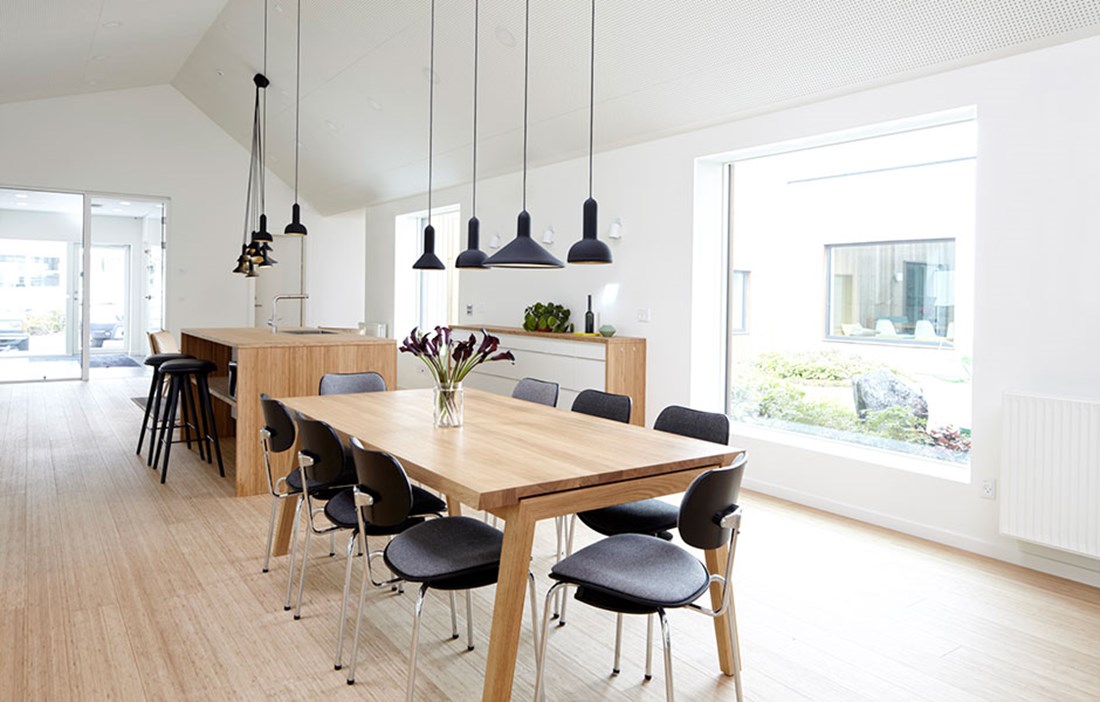HOPE, RELIEF, DESPAIR and grief. The seven little white buildings next to the hospital in Naestved, Denmark, are full of emotions. Part of the nationwide “Livsrum” project, the buildings house the hospital’s cancer advisory service – a place where patients and relatives can come and talk to counsellors and meet others in the same situation or talk in groups before and after their chemotherapy. There are also various activities on offer, such as physical fitness, yoga and painting. To create spaces that could handle all this, the architects at Effekt wanted to produce something that exuded calm and harmony in every nook and cranny of the seven buildings.
“It was important for us that Livsrum was an antidote to the clinical, modern institutional feel that is so common in hospital architecture. We wanted to create a place that felt safe and nurturing. Like being at home. We went as far as we possibly could in terms of design and architecture to create this atmosphere,” explains Tue Hesselberg Foged, chief architect for Livsrum in Naestved.
ALTHOUGH THE IDEA of “healing architecture” feels modern, it is far from new. Back in 1930, architect and designer Alvar Aalto designed Paimio Sanitorium in Finland, a building that still serves as a blueprint for how hospital buildings can meet the physical and mental needs of patients. Aalto’s terraces gave the hospital’s tuberculosis patients access to sun and fresh air, but they were also aesthetically pleasing. The interior was tailored so that patients who might be there for a while would feel right at home. One of the organisations that has built on Aalto’s legacy is the Maggie Keswick Jencks Cancer Caring Centres Trust in the UK, which commissions small but ambitious drop-in centres with therapeutic interiors for cancer sufferers and their relatives.
While Maggie’s Cancer Caring Centres are expensive projects designed by some of the biggest names in architecture, Denmark has chosen to encourage small, innovative practices. Effekt had a strict budget, which brought several challenges, but the team of architects managed to stick to it without deviating from the central concept of a harmonious and homely building. This was expressed in two ways, with great care taken over all the measurable factors such as perfect indoor climate, good natural light and acoustics. However it was also important get the whole feeling right, inside and out, and that was not something they could measure.
“We decided early on that we wanted to build Livsrum like a little village, rather than a big complex. That’s why we designed seven small buildings, of varying sizes and with different functions, which are connected for easy access between them. The buildings are arranged around two gardens, so you always have access to an outdoor space, wherever you are.”
CREATING TRANQUIL OUTDOOR spaces between the buildings was important, since Livsrum is sandwiched between two major roads – one leading into Naestved and the other to the hospital, with ambulances coming and going all the time. One of the gardens is designed like a kind of Japanese Zen garden with running water, plants and small mounds. The other functions as a courtyard area for various activities, a place to sit and eat, practise yoga, have a meeting or hold a talk. Many of the windows overlooking the courtyard are designed so you can sit on a cushion in the half-metre deep window alcoves. A great deal of work went into the windows at Livsrum. In the library, as in almost all the other rooms, there are windows in every direction, giving a sense of being in a little house.
“The windows might look randomly scattered, but they’re not. We’ve put a lot of thought into both the size and positioning. We made some of the windows smaller to stop it getting too warm in the buildings at certain times of day. But we also took other factors into account. In one of the consulting rooms, for example, we moved a window slightly so you get a direct view of the chapel sign on the other side of the street. The aim at all times was to create as calm and pleasant an experience as possible.”
Wood played a major role in creating the atmosphere the architects were after. Of all the materials available, wood has a particularly positive effect on people’s wellbeing. Studies have shown that the material affects the quality of the indoor air, the humidity balance, comfort and acoustics.
“Wood is an organic material that supports sustainable development and creates a multisensory quality in a room. Its chemical composition is good for the indoor climate, with wood acting as an air purifier. But the main point is the pleasant associations many people have with wood, as well as the purely physical properties of the material. The bamboo chosen for the flooring and around the windows is a great example of this,” says Lindroos, who continues:
“We wanted to use a light material and thought untreated bamboo was the ideal solution. Bamboo is also pleasant to the touch, it’s warm and attractive, which made it ideal for the floors and the window alcove surrounds, where you can sit and look out. Leaving the material untreated means it will age over time and take on a beautiful patina. It will look like it has been used, which will contribute to the homely feel.”
Many of the fixtures and fittings in Livsrum are also bamboo, with the proud Danish furniture tradition embodied in the tables, chairs and kitchen fittings. An entire wall in the main room is also lined with built-in bamboo shelving. Coming in through Livsrum’s main entrance, visitors are greeted by a large and beautiful oak dining table.
“Instead of seeing a reception desk, which would feel formal and more hospital-like, the first thing you encounter is an oversized dining table. We designed it specifically for this project. There is space for several groups at the same time, and a counsellor is always on hand. You can sit down at any time and have a coffee, sit and talk or just listen.”
The gable walls that face inwards, towards the courtyard and garden, are clad in larch, another wood chosen for its aesthetic qualities. The pale walls make the building warm and welcoming. The gable walls that make up the building’s two entrances also use larch. All the gable walls are treated with oil to make them resistant to the windy Danish coastal climate. No fire retardant has been applied – thick, flame-resistant wood panels have been used instead, partly out of a desire to keep the project free from chemicals. Another benefit of larch is its acoustic properties. Effekt worked with an acoustics engineer both internally and externally to achieve a comfortable sound environment everywhere. The result is particularly noticeable in the inner courtyards, where you can sit in peace and quiet, despite being so close to a busy road.
The structural elements of Livsrum are made from Swedish spruce. The walls and roofs are made from prefabricated panels manufactured by local joiners and then assembled on site.
“I believe, and I think we’re already seeing, that wood is becoming increasingly popular as a construction material. Bamboo, which we’ve used widely in Livsrum, is one material I’m sure will do well. Wood is fantastically sustainable and the material also gives buildings a very special feeling and atmosphere. I predict that wood is going to start being used much more widely as a construction material instead of steel and concrete,” comments Tue Hesselberg Foged
MOST OF THE EXTERIOR surfaces of the building, both the facades and the roofs, are clad in white fibre cement. The material is deceptively similar to wood, but is not a pure wood product. The budget did not stretch to wooden facades, but Tue Hesselberg Foged feels Effekt has got the material choices just right.
“The sheets overlap each other and the screws are countersunk, which makes the building look like some Danish summerhouses.”
The homely feel throughout is much appreciated by the hospital’s cancer patients. And not only by them.
“The hospital patients like spending time here, as do others who are not cancer sufferers. Many of the hospital’s doctors choose to hold their meetings here instead of in the clinical hospital environment. I think that shows we’ve succeeded. We’ve created a comfortable place that people enjoy being in.”
Text Erik Bredhe























